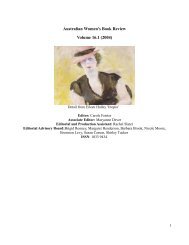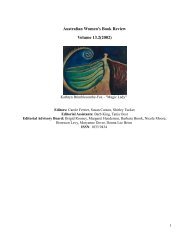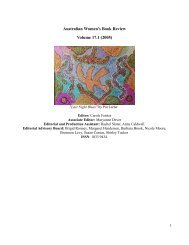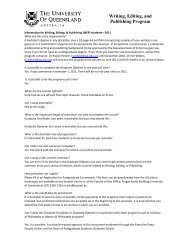Australian Women's Book Review Volume 14.1 - School of English ...
Australian Women's Book Review Volume 14.1 - School of English ...
Australian Women's Book Review Volume 14.1 - School of English ...
You also want an ePaper? Increase the reach of your titles
YUMPU automatically turns print PDFs into web optimized ePapers that Google loves.
superficial level. When she does drop the public voice <strong>of</strong> narrative and exposition, the moments are<br />
insightful and revealing: 'I have never felt beautiful on land the way I do when I'm in the water. When<br />
you're at that stage <strong>of</strong> fitness and going into competition it's like a love affair…. It is an extremely<br />
sensuous experience to swim at that level <strong>of</strong> oneness with the water, feeling a tingling sensation on the<br />
fingertips and the skin' (p.109).<br />
Interestingly, the most personal and engaging parts <strong>of</strong> the book are the early sections where she recalls<br />
her childhood growing up working class in Balmain. Fraser evokes a suburb and a hard way <strong>of</strong> life now<br />
largely vanished, and she tells some wonderful anecdotes. She worked for the SP bookie, Lenny<br />
McPherson at the age <strong>of</strong> eleven, and she describes how she got her friends to dive bomb the middleclass<br />
swim squad from Drummoyne when they tried to train in her pool. Fraser really did achieve<br />
against the odds, with no AIS, no sponsors, no heated pools, no media jobs to help her, just full-time<br />
work and full-time training. In this way, her early working-class life is central to understanding her<br />
drive, rebelliousness, and search for recognition (<strong>of</strong>ten from famous people). If we don't necessarily<br />
discover a different Dawn, we at least gain an account <strong>of</strong> a different era <strong>of</strong> sport.<br />
And we also see how national legends get (re)constructed. By this, I don't just mean the tendency in the<br />
book for Dawn to replace self-analysis with the easier option <strong>of</strong> reverting to the national stereotypes <strong>of</strong><br />
larrikinism, working-class battlers, or the working class made good. I mean, as well, the basic narrative<br />
<strong>of</strong> Dawn's rise and fall from grace, and her eventual reinstatement to her rightful place in the national<br />
pantheon as 'Our Dawn' (indeed, she has been described as a national living treasure). Her slow climb<br />
back to public prominence in the 1980s and 1990s is a case study <strong>of</strong> the intersection <strong>of</strong> an ex-athlete<br />
with the codes <strong>of</strong> national identity, and the expanding sports industry and bureaucracy. Thus Dawn:<br />
One Hell <strong>of</strong> a Life provides dual insights: first, into a collective psyche constructed through those<br />
stereotypes, desirous <strong>of</strong> heroes, and in love with sport; and second, into a working-class female<br />
champion who relies on those largely male mythologies for a sense <strong>of</strong> self (and an income).<br />
Margaret Henderson is a lecturer in the Contemporary Studies Program at the University <strong>of</strong><br />
Queensland, Ipswich Campus. She is writing a cultural and political history <strong>of</strong> twentieth century<br />
<strong>Australian</strong> feminism.<br />
66








